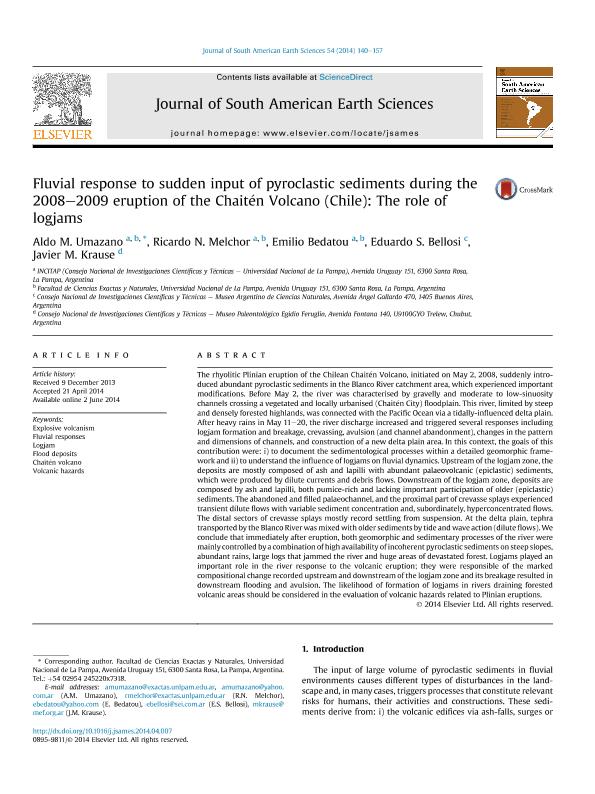Mostrar el registro sencillo del ítem
dc.contributor.author
Umazano, Aldo Martin

dc.contributor.author
Melchor, Ricardo Nestor

dc.contributor.author
Bedatou, Emilio

dc.contributor.author
Bellosi, Eduardo Sergio

dc.contributor.author
Krause, Javier Marcelo

dc.date.available
2017-06-29T19:38:07Z
dc.date.issued
2014-10
dc.identifier.citation
Umazano, Aldo Martin; Melchor, Ricardo Nestor; Bedatou, Emilio; Bellosi, Eduardo Sergio; Krause, Javier Marcelo; Fluvial response to sudden input of pyroclastic sediments during the 2008–2009 eruption of the Chaitén Volcano (Chile): The role of logjams; Elsevier; Journal of South American Earth Sciences; 54; 10-2014; 140-157
dc.identifier.issn
0895-9811
dc.identifier.uri
http://hdl.handle.net/11336/19184
dc.description.abstract
The rhyolitic Plinian eruption of the Chilean Chaitén Volcano, initiated on May 2, 2008, suddenly introduced abundant pyroclastic sediments in the Blanco River catchment area, which experienced important modifications. Before May 2, the river was characterised by gravelly and moderate to low-sinuosity channels crossing a vegetated and locally urbanised (Chaitén City) floodplain. This river, limited by steep and densely forested highlands, was connected with the Pacific Ocean via a tidally-influenced delta plain. After heavy rains in May 11–20, the river discharge increased and triggered several responses including logjam formation and breakage, crevassing, avulsion (and channel abandonment), changes in the pattern and dimensions of channels, and construction of a new delta plain area. In this context, the goals of this contribution were: i) to document the sedimentological processes within a detailed geomorphic framework and ii) to understand the influence of logjams on fluvial dynamics. Upstream of the logjam zone, the deposits are mostly composed of ash and lapilli with abundant palaeovolcanic (epiclastic) sediments, which were produced by dilute currents and debris flows. Downstream of the logjam zone, deposits are composed by ash and lapilli, both pumice-rich and lacking important participation of older (epiclastic) sediments. The abandoned and filled palaeochannel, and the proximal part of crevasse splays experienced transient dilute flows with variable sediment concentration and, subordinately, hyperconcentrated flows. The distal sectors of crevasse splays mostly record settling from suspension. At the delta plain, tephra transported by the Blanco River was mixed with older sediments by tide and wave action (dilute flows). We conclude that immediately after eruption, both geomorphic and sedimentary processes of the river were mainly controlled by a combination of high availability of incoherent pyroclastic sediments on steep slopes, abundant rains, large logs that jammed the river and huge areas of devastated forest. Logjams played an important role in the river response to the volcanic eruption; they were responsible of the marked compositional change recorded upstream and downstream of the logjam zone and its breakage resulted in downstream flooding and avulsion. The likelihood of formation of logjams in rivers draining forested volcanic areas should be considered in the evaluation of volcanic hazards related to Plinian eruptions.
dc.format
application/pdf
dc.language.iso
eng
dc.publisher
Elsevier

dc.rights
info:eu-repo/semantics/openAccess
dc.rights.uri
https://creativecommons.org/licenses/by-nc-sa/2.5/ar/
dc.subject
Explosive Volcanism
dc.subject
Fluvial Responses
dc.subject
Logjam
dc.subject
Flood Deposits
dc.subject
Chaitén Volcano
dc.subject
Chile
dc.subject.classification
Vulcanología

dc.subject.classification
Ciencias de la Tierra y relacionadas con el Medio Ambiente

dc.subject.classification
CIENCIAS NATURALES Y EXACTAS

dc.title
Fluvial response to sudden input of pyroclastic sediments during the 2008–2009 eruption of the Chaitén Volcano (Chile): The role of logjams
dc.type
info:eu-repo/semantics/article
dc.type
info:ar-repo/semantics/artículo
dc.type
info:eu-repo/semantics/publishedVersion
dc.date.updated
2017-06-28T19:43:05Z
dc.journal.volume
54
dc.journal.pagination
140-157
dc.journal.pais
Países Bajos

dc.journal.ciudad
Amsterdam
dc.description.fil
Fil: Umazano, Aldo Martin. Consejo Nacional de Investigaciones Científicas y Técnicas. Instituto de Ciencias de la Tierra y Ambientales de La Pampa. Universidad Nacional de La Pampa. Facultad de Ciencias Exactas y Naturales. Instituto de Ciencias de la Tierra y Ambientales de La Pampa; Argentina
dc.description.fil
Fil: Melchor, Ricardo Nestor. Consejo Nacional de Investigaciones Científicas y Técnicas. Instituto de Ciencias de la Tierra y Ambientales de La Pampa. Universidad Nacional de La Pampa. Facultad de Ciencias Exactas y Naturales. Instituto de Ciencias de la Tierra y Ambientales de La Pampa; Argentina
dc.description.fil
Fil: Bedatou, Emilio. Consejo Nacional de Investigaciones Científicas y Técnicas. Instituto de Ciencias de la Tierra y Ambientales de La Pampa. Universidad Nacional de La Pampa. Facultad de Ciencias Exactas y Naturales. Instituto de Ciencias de la Tierra y Ambientales de La Pampa; Argentina
dc.description.fil
Fil: Bellosi, Eduardo Sergio. Consejo Nacional de Investigaciones Científicas y Técnicas. Oficina de Coordinación Administrativa Parque Centenario. Museo Argentino de Ciencias Naturales "Bernardino Rivadavia"; Argentina
dc.description.fil
Fil: Krause, Javier Marcelo. Museo Paleontológico Egidio Feruglio; Argentina. Consejo Nacional de Investigaciones Científicas y Técnicas; Argentina
dc.journal.title
Journal of South American Earth Sciences

dc.relation.alternativeid
info:eu-repo/semantics/altIdentifier/doi/http://dx.doi.org/10.1016/j.jsames.2014.04.007
dc.relation.alternativeid
info:eu-repo/semantics/altIdentifier/url/http://www.sciencedirect.com/science/article/pii/S0895981114000492
Archivos asociados
